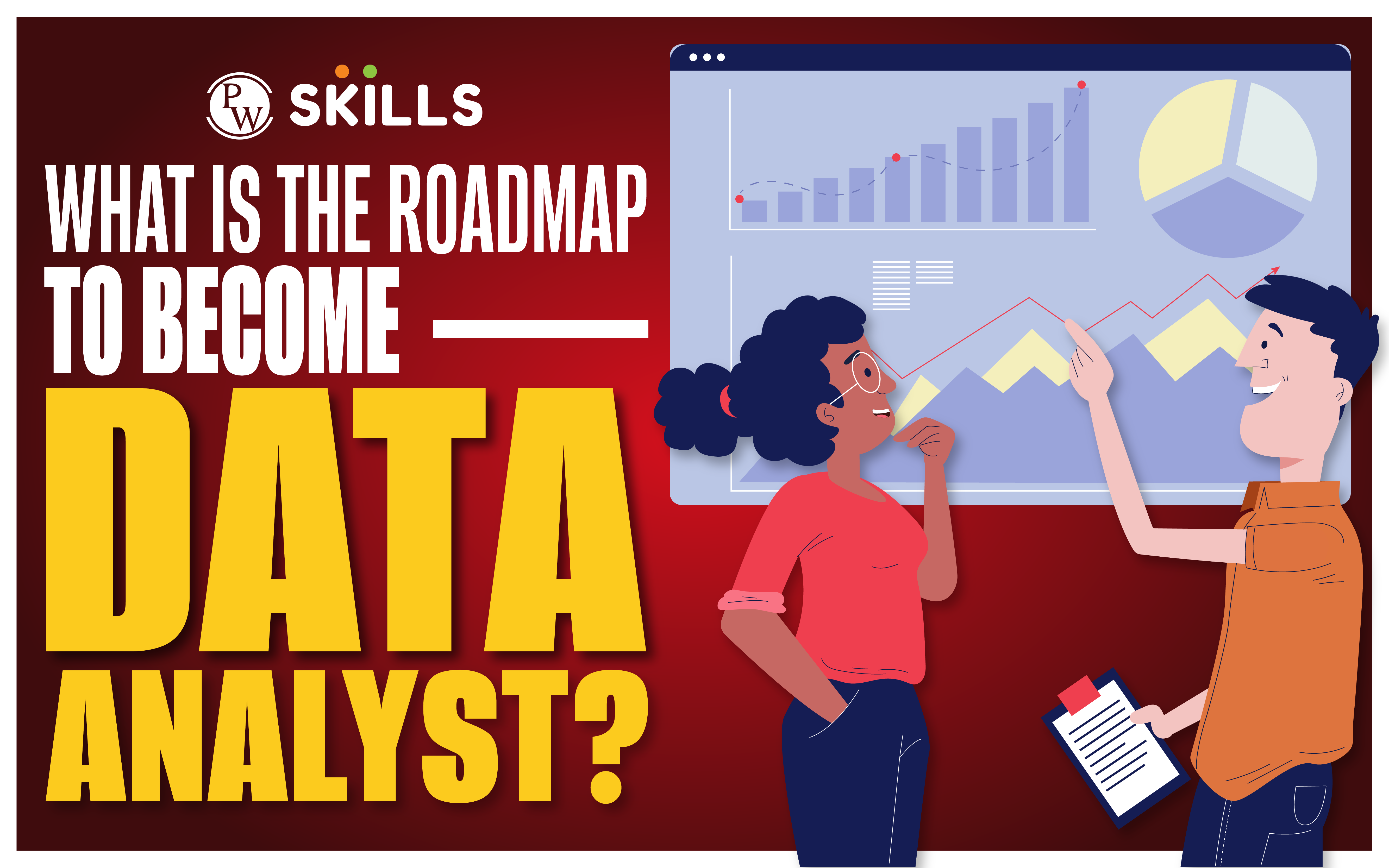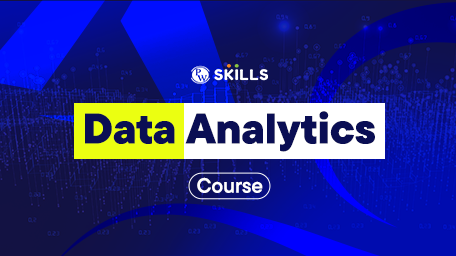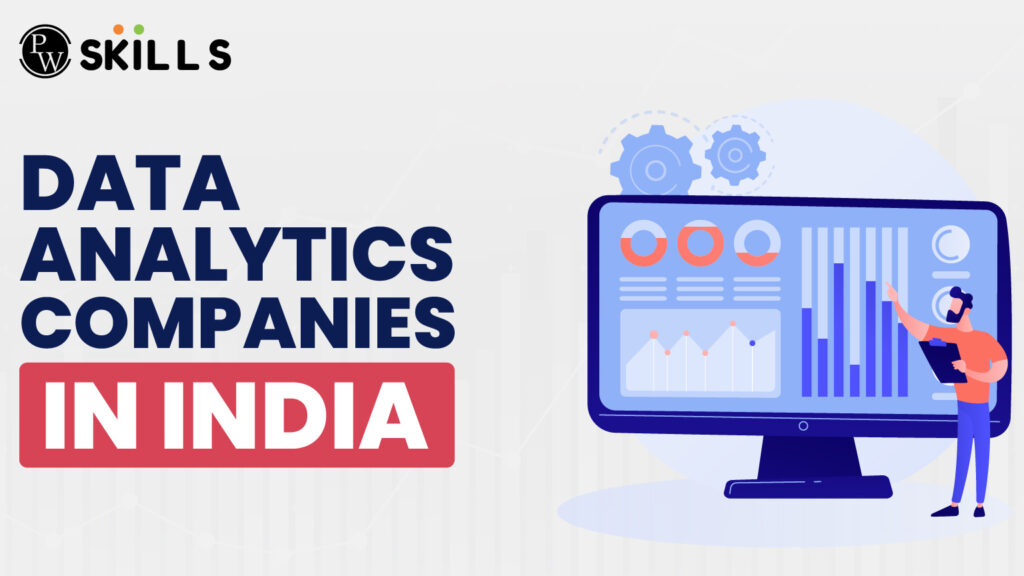Data Analyst Roadmap: In our increasingly digitised world, data has become a cornerstone of decision-making across industries. Businesses and organisations rely on data to gain insights, make informed decisions, and stay competitive. At the forefront of this data revolution are data analysts, professionals equipped with the skills to transform raw data into actionable intelligence. In this blog, we’ll give you the complete data analyst roadmap 2024, a data analyst’s responsibilities, skills required, and much more!
What is Data Analysis?
Data analysis means examining, cleaning, transforming, and modelling information to unveil valuable insights, draw conclusions, and aid decision-making. This process applies statistical and mathematical techniques to reveal patterns, trends, and meaningful details within datasets.
In our swiftly evolving and interconnected world, data analysis stands as a vital instrument for businesses and organisations. It empowers them to make decisions grounded in evidence, recognize opportunities, and address potential risks. From improving operational efficiency to optimising marketing strategies, data analysis plays a pivotal role in driving success.
Key Concepts and Processes Involved in Data Analysis
The data analysis process typically involves several key steps:
- Data Collection: Gathering relevant data from various sources, which may include databases, surveys, or real-time systems.
- Data Cleaning: Detecting and fixing errors, inconsistencies, or missing values in the dataset for accuracy.
- Exploratory Data Analysis (EDA): Analysing and visualising data to grasp its structure, patterns, and relationships.
- Statistical Analysis: Applying statistical methods for inferences, predictions, and hypothesis validation.
- Data Interpretation: Communicating findings to stakeholders in a clear and understandable manner, often using data visualisation tools.
Recommended Technical Course
- Full Stack Development Course
- Generative AI Course
- DSA C++ Course
- Data Analytics Course
- Python DSA Course
- DSA Java Course
Responsibilities of a Data Analyst
The data analyst’s job goes beyond basic number crunching and stats. In the ever-changing data scene, they’re vital for pulling out meaningful insights, influencing decisions, and boosting an organisation’s success. Let’s dig into the daily tasks that shape a data analyst’s role.
| Responsibilities of a Data Analyst | |
| Data Cleaning and Preparation | Resolve Data Quality Issues: Analysts ensure data accuracy by addressing missing values, outliers, and inconsistencies.
Data Transformation: Transforming raw data into a structured format suitable for analysis, including normalisation, standardisation, and the creation of derived variables. |
| Data Exploration | EDA Techniques: Using statistics and visualisation tools to explore data, revealing patterns, trends, and outliers.
Feature Engineering: Identifying and crafting meaningful features to boost data understanding and analytical model performance. |
| Statistical Analysis | Hypothesis Testing: Designing and conducting statistical tests to validate hypotheses and draw conclusions from the data.
Regression Analysis: Applying regression models to understand relationships between variables and make predictions. |
| Data Visualization | Visualise Data: Crafting clear charts, graphs, and dashboards to share findings with both tech and non-tech folks.
Build Dashboards: Constructing interactive dashboards for users to explore and gain real-time insights. |
| Reporting | Generate Reports: Producing reports summarising key findings, trends, and actionable insights for decision-makers.
Automated Reporting: Implementing automated reporting processes to streamline the generation of routine reports and ensure timely delivery |
Also read: 11 Data Analyst Skills You Need to Get Hired in 2024
The Role of Data Analysts in Decision-Making Processes
Data analysts serve as key contributors to decision-making processes within an organisation. By providing accurate and timely insights, they empower decision-makers to:
- Identify Opportunities: Uncover opportunities for growth, innovation, and efficiency improvements by analysing market trends, customer behaviour, and operational data.
- Mitigate Risks: Anticipate and mitigate potential risks by identifying patterns or anomalies in data that may impact the organisation.
- Optimise Strategies: Inform strategic planning and optimization of business strategies based on data-driven insights and feedback.
Collaborative Aspects of Working with Different Teams and Stakeholders
Effective collaboration is a crucial aspect of a data analyst’s role. Data analysts often work closely with various teams and stakeholders, including:
- Business Analysts: Collaborating to align data analysis with broader business objectives and strategies.
- Data Scientists: Working in conjunction to explore advanced analytical techniques and predictive modelling.
- Management and Executives: Communicating findings in a clear and concise manner to support decision-making at the highest levels of the organisation.
Why Data Analysis?
Choosing a career in data analysis can be a rewarding decision for several reasons:
- High Demand: The demand for skilled data analysts is consistently high across various industries. Businesses gather extensive data today, requiring professionals skilled in analysing and extracting valuable insights.
- Lucrative Salaries: The demand for data analysis skills results in professionals commanding competitive pay. Recognizing the importance of data-driven decision-making, organisations invest in proficient analysts.
- Career Advancement: Data analysis serves as a gateway to advanced roles in data science, machine learning, or management. It offers a clear path for career progression, allowing individuals to deepen their expertise or take on more significant responsibilities.
- Global Significance: The skills acquired in data analysis transcend geographic boundaries. With data serving as a universal language, professionals in this field find opportunities worldwide.
- Remote Work Opportunities: The nature of data analysis work often allows for remote work possibilities, providing flexibility in terms of work location.
Also read: What is Data Analysis? Responsibilities, Types, Qualifications, How to Become One
The Value of Data Analysis in Informing Business Strategies
The value of data analysis extends beyond the extraction of insights—it directly influences business strategies. Here are some ways in which data analysis contributes to strategic decision-making:
- Understanding Customers: Analysing customer data enhances organisations’ comprehension of their target audience, leading to more personalised and effective marketing strategies.
- Operational Streamlining: Identifying inefficiencies and bottlenecks through data analysis enables organisations to streamline operations and cut costs.
- Competitive Edge: Utilising data for insights into market trends, competitor strategies, and customer preferences provides a competitive advantage.
Future Trends and the Growing Demand for Data Analysts
As technology continues to advance, the demand for skilled data analysts is expected to grow. Emerging trends shaping the future of data analysis include:
- Machine Learning Integration: The integration of machine learning algorithms into data analysis processes for more accurate predictions and automated decision-making.
- Big Data Analytics: Dealing with large and complex datasets to extract valuable insights, requiring advanced analytical skills.
- Ethical Data Practices: The increasing importance of ethical considerations in data analysis, including privacy, bias mitigation, and responsible data use.
Can Anyone Become a Data Analyst Without Any Experience?
Many think you need a computer science or stats background to be a data analyst. But, diverse backgrounds can thrive with the right skills, determination, and ongoing learning.
Strategies for Transitioning into a Data Analyst Role with No Prior Experience
- Developing Technical Skills:
-
-
- Programming Languages: Learn programming languages commonly used in data analysis, such as Python and R.
- Data Manipulation: Acquire skills in manipulating and cleaning data using tools like Pandas and SQL.
- Statistical Analysis: Gain proficiency in statistical analysis techniques.
-
- Building a Strong Foundation:
-
-
- Online Courses and Certifications: Enrol in online courses and certifications offered by platforms like PW Skills.
- Self-Study: Explore relevant textbooks, online resources, and practice datasets to enhance your knowledge.
-
- Hands-On Experience:
-
- Projects: Undertake small data analysis projects to apply your skills and build a portfolio.
- Internships or Volunteer Work: Gain practical experience through internships or volunteer opportunities, even if unpaid.
Data Analyst Roadmap – Skills Required
Core Technical Skills Necessary for Data Analysts
Proficiency in Programming Languages
- Python: Widely used for data analysis and machine learning applications.
- R: Especially popular for statistical analysis and data visualisation.
Data Manipulation and Cleaning
- Pandas: A powerful Python library for data manipulation and analysis.
- SQL: Essential for querying and managing relational databases.
Statistical Analysis and Interpretation
- Hypothesis Testing: Understanding statistical hypothesis testing for drawing conclusions from data.
- Descriptive Statistics: Analysing and summarising key features of a dataset.
Essential Soft Skills for Effective Data Analysis
Communication Skills
- Data Storytelling: Effectively communicating insights through compelling narratives.
- Visual Communication: Creating clear and impactful visualisations for diverse audiences.
Problem-Solving Abilities
- Critical Thinking: Analysing problems systematically and making informed decisions.
- Troubleshooting: Identifying and resolving issues in data and analyses.
Attention to Detail and Critical Thinking
- Data Quality: Ensuring accuracy and reliability of data through meticulous attention to detail.
- Pattern Recognition: Identifying patterns and trends in data to derive meaningful insights.
Also read: What Qualification Is Required for a Data Analyst?
Career Path of a Data Analyst
Here’s what the typical position of a data analyst looks like:
Entry-Level Positions and Opportunities for Beginners
Aspiring data analysts often start in entry-level positions such as:
- Data Analyst Intern: Gain hands-on experience through internships, applying theoretical knowledge to real-world scenarios.
- Junior Data Analyst: Work on smaller projects under the guidance of senior analysts, honing technical and analytical skills.
Mid-Career Advancements and Specializations
With experience, data analysts can progress to mid-career roles and explore specialisations:
- Senior Data Analyst: Take on more complex projects, mentor junior analysts, and contribute to strategic decision-making.
- Industry Specialisations: Focus on specific industries such as finance, healthcare, or e-commerce, gaining expertise in domain-specific data analysis.
Senior Roles and Leadership Opportunities in Data Analytics
- Lead Data Analyst: Oversee a team of analysts, coordinate projects, and collaborate with senior management on high-level strategic initiatives.
- Data Analytics Manager/Director: Manage the overall data analytics function within an organisation, shaping the data strategy and driving innovation.
Additional Resources and Learning Platforms
Networking Opportunities and Communities for Knowledge Sharing
- Meetup Groups: Join local or online meetup groups focused on data analysis and attend networking events.
- LinkedIn and Twitter: Follow industry experts, participate in discussions, and connect with professionals in the field.
Tips for Continuous Learning and Staying Updated in the Field
- Subscribe to Industry Publications: Stay informed about the latest trends, tools, and best practices in data analysis.
- Attend Conferences and Webinars: Participate in conferences and webinars to learn from experts, gain insights, and expand your professional network.
Also read: 5+ Best Data Analytics Certifications for Success in Your Career 2024!
Conclusion
Becoming a data analyst requires blending technical expertise, interpersonal skills, and hands-on know-how. Data analysis, a vibrant domain, presents varied chances for people of different backgrounds. Aspiring analysts, adhering to the provided Data Analyst Roadmap, can not just enter but also flourish and progress in their careers. With the escalating need for data-driven insights, the role of analysts is crucial in moulding the future of global businesses and organisations.
If you want to become a successful data analyst, the PhysicsWallah’s Data Analytics courses are just what you need to succeed in your career! Our courses are mentored by industry leaders and teach you everything in detail. So, don’t wait! Enrol now! Use the coupon code – “READER” and get an exclusive discount on all courses from PW Skills.
For Latest Tech Related Information, Join Our Official Free Telegram Group : PW Skills Telegram Group






